|
Each week our specialists publish a research paper about Art and its markets.
Antiques, painting, drawing, sculpture, furniture, fine art, porcelain, ceramic, work of art, carpet, tapestry, silver are among the subject studied.
You can receive our free weekly research paper by email by subscribing to our newsletter.
 The 26 and 27 October, Sotheby's Paris in association with Piasa organizes the auction of the collection Fabius Frères. Over 400 works will be sold for an estimation of 9 to 14 million euros.
Sculptures by Antoine-Louis Barye, Jean-Francois Carpeaux, furniture by Grohé, Dufin and Diehl, works of art by Theodore Deck or Maurice Marinot, drawings and paintings of the nineteenth century by Jean Beraud or Aldophe Yvon. The viewing for the exceptional collection Fabius is opened since the 21th at the Galerie Charpentier.
In sculpture, the collection is the largest nineteen century collection ever sold at auction. Two major artists - Jean-Baptiste Carpeaux (1827-1875) and Antoine-Louis Barye (1795-1875) - transform the sales event. Note particularly the large marble group of Daphnis and Chloe by Jean-Baptiste Carpeaux, estimated between 1 million to 1 500 000 €. The sale also includes 51 bronzes by Antoine-Louis Barye with Theseus and the Minotaur, from the collections of the King of Portugal and estimated 200 000 to 300 000 €.

The selection includes some classic eighteenth century furniture and nineteenth most exuberant creations and classic furnishings from Louis XIV to the Empire style. Decorative arts, ceramics and glass are represented by a wide variety of pieces, including unique works by Theodore Deck, Eugene and Maurice Collinot Marinot.
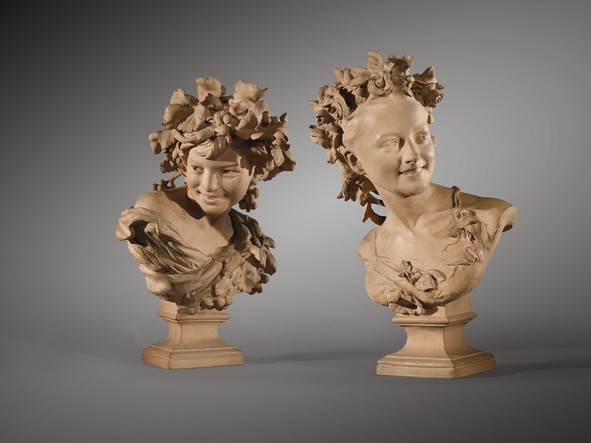
The history of the collection dates back to Elie Fabius, who has a prestigious gallery in Paris in 1882. Passionate about Napoleon and Lafayette, historical memories and sculptures by Carpeaux and Barye, Fabius put the nineteenth century style in fashion. The work of Elie Fabius was continued by the first of his son and then by his grandson, son Francis, brother of Laurent who died in 2006.
To know more : www.sothebys.com
Illustrations :
Illustration 1 : lot 178 - Exceptionnelle paire de vases Médicis, deuxième grandeur en porcelaine dure de Sèvres, l’un daté 1811, peints et signés par Jean-François Robert. À décor polychrome sur fond écaille sur l’un de l’Empereur devant les coteaux de Bellevue et de Meudon, l’autre de l’Empereur et Marie-Louise en calèche devant le château de Saint-Cloud ; au revers, deux griffons affrontés autour d’une vasque flammée et encadrés de rinceaux et palmettes en or, guirlandes de grappes de raisins sur le col et frise de feuillage en dorure, socles carrés en bronze doré. Hauteur : 66 cm. Estimation : 500 000-800 000 €
» More

 Carmontelle was a fine artist specialized in drawings and watercolors. He organized the Duke of Orleans, future Philippe-Egalite, parties’ and was an inventor of genius. Very famous in the second part of the 18 th century is fame did not cross the mid 19 th century.
Yet fans and collectors, starting with the Duke of Aumale, make no mistake about his talent s his auction result can attest.
Let’s discover the artist and his work.
His beginning
Louis de Carmontelle or Carmontelle whose real name was Louis Carrogis was born in Paris in 1717 from a father shoemaker. After studying drawing and geometry, he became an engineer at the age of 23. He then entered the service of the Duke of Luynes at Dampierre Castle as a tutor in mathematics and drawings of the children of the Duke.
» More

 Medieval Art has done very well her this year. Several pieces have attracted the interest of French and international collectors in particular during two auctions by PIASA (Paris) in January and June.
Some surprises as the world record of a fifteenth century Burgundy walnut and gold polychrome apostle, traditionally attributed to the altarpiece of Theuley (Haute-Saône), which fetched to 202,000 Euros, breaking the final result of another statuette from the same altarpiece sold for 190,000 Euros in 2007 in a countryside auction. Both sculptures were expertise by Laurence Fligny who is the specialist in the field in charge of those two sales.
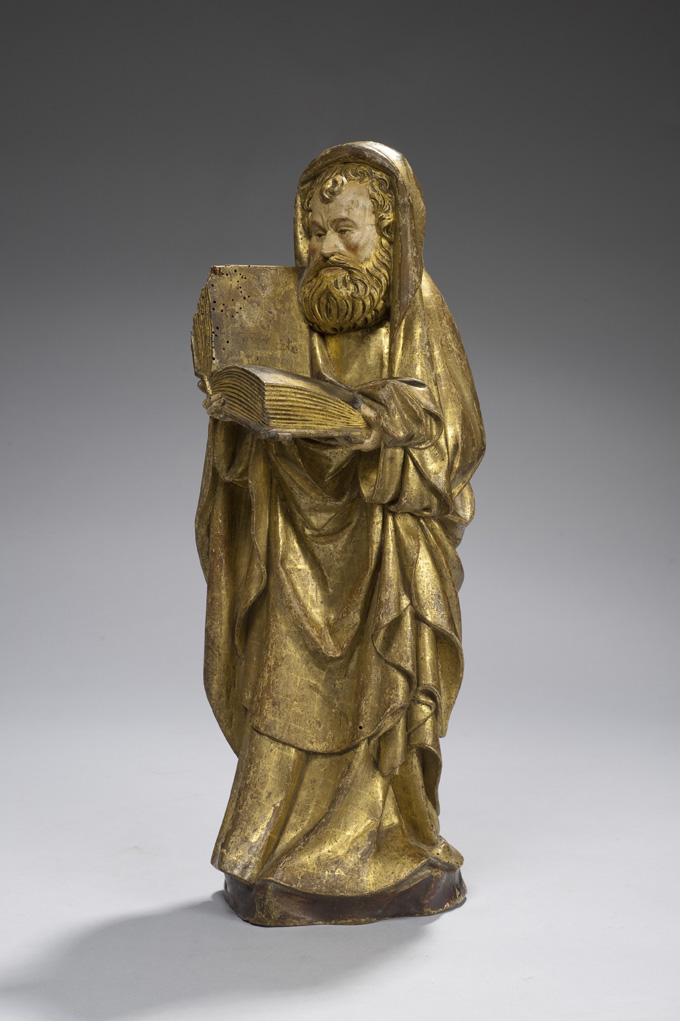
Another surprising result for a small sculpture by Leonardo Kern (1588-1662) depicting two children playing, one straddling the other, it reached the peaks of 165, 000 Euros. It was a happy discovery for vendors who could not imagine owning a small masterpiece of this German artist who is very popular on the Germanic market.
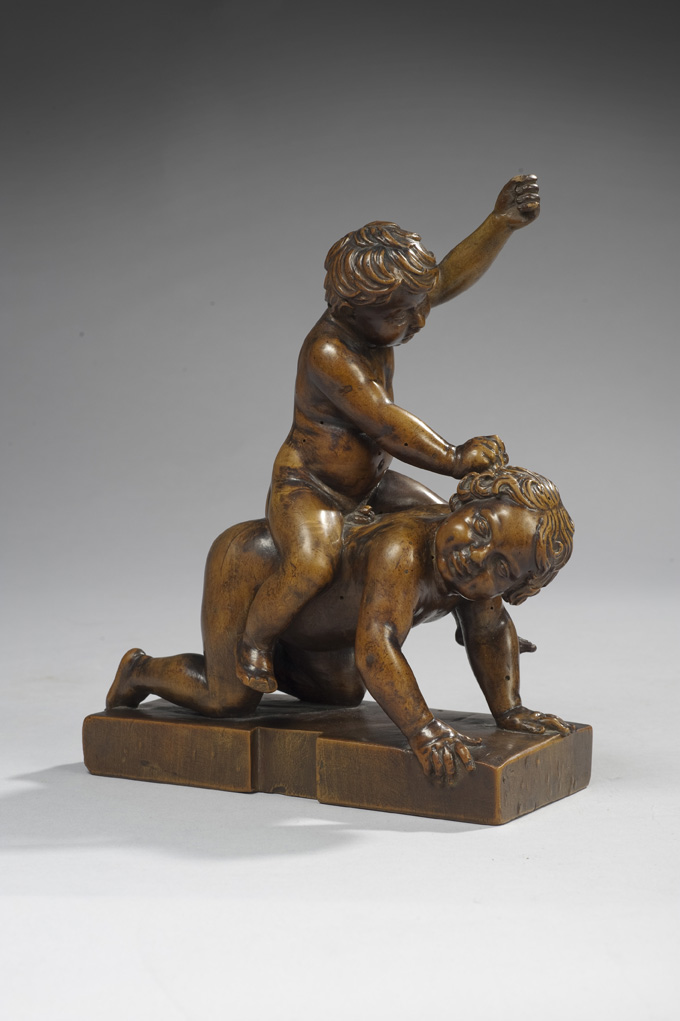
The Italian art with a seven panels painted ceiling from the mid-fifteenth century, depicting characters in flower buttons with a very handsome young knight holding a sword and a banner. This series attracted many bidders and was finally sold to the trade for 80,000 Euros.

Our next auction, actually in preparation, will focus on fine furniture including a beautiful and rare cassone, an armoire hiding a painted cabinet probably from the Loire Valley or Burgundy's second third of the seventeenth century. Note also in this sale an exceptional capital, sophisticated interpretation of the Corinthian one with acanthus leaves of great finesse. The quality of the stone, very fine-grained limestone and style suggest that this capital could come from the cloister of Notre Dame en Vaux at Chalons-en-Champagne.
The Mediaval Art is specific as it combines various works of art ranging from furniture to sculpture and through many techniques and materials as diverse as wrought iron, ivory, enamel painted or champlevé, wood, stone or glass. We can visit the whole of Europe through the productions of Germanic, Italian, Iberian, Flemish, English artists. In addition, many of these works have retained a strong spiritual presence that continues to exercise their fascination today.
Our next meeting will be on December the 2nd with PIASA at Drouot, with over 200 lots ranging from low estimates to top for some major masterpieces of medieval or Renaissance art.
Laurence FLIGNY
» More

 Of all the great sculptors of the second half of the 19th century, Jean-Baptiste Carpeaux is probably one of the best known and his name evokes in the minds of many a sculpture in bronze, marble or terracotta seen at auction, in a gallery, at Drouot or in a museum.
His beginnings
Jean-Baptiste Carpeaux was born in 1827 in Valenciennes in a working class family particularly poor. Son and grandson of a mason, he joined early on as an apprentice to a master plasterer, training applicant to know how to draw, is enrolled in the Academy de Peinture, Sculpture et Architecture in Valenciennes. In 1838 he moved to Paris and took courses at the Ecole Gratuite drawing, also called Petite Ecole, until 1843. » More

 Older than 60 years, this buffet-sideboard is part of the French history. It was produced at the request of the Ministry of War to equip the interiors of the victims of the 2nd World War. Brief overview of this highly functional piece of furniture which lays the foundations of design.
Before IKEA
Designed by René Gabriel, a leading French designer furniture specialist in series, this piece of simple structure devoid of ornament, is a simple buffet, both chest of drawers and armoire. It fits into many apartments just after the war in late 1940/early 1950. These homes, rebuilt in the emergency from Orleans to Le Havre, sheltered the victims to whom this buffet was sold at a very symbolic price.
A successful design
In the history of furniture, this is perhaps one of the first pieces of furniture in France to truly answer the fundamental principles of Design: objects with simple shapes and useful for the many.
» More

 On July 20, the National Assembly passed a law reforming and liberalizing public auction in France. The implementing decree came into force on 1 September and museums are the primary beneficiaries. » More


 On June 28, Bonhams London organized an auction of pendulums, clock and regulators of great quality. The lot 81 held our attention. It is an important French clock dating from the revolutionary period by François-Joseph Hartmann comprising several dials sold with the buyer premium for the sum of £322 400 (approximately 400.000 Euros).
Let’s have a closer look on this clock which will interest clocks lovers as much as the decorative art specialist.
The clock
An ormolu automat clock, the central part including eight dials is surmounted by a victory holding a trumpet. The dials are separated by flowers and fruits. It is flanked of two columns of helicoids forms overcome by a finished bulb and leaves. The oval base presents a rich ornamentation of stylized lotus leaves on the front.
It rests on six small feet spinning tops.
The eight dials include :
-a Republican and Gregorian complete calendar including the seasons.
-the phases of the moon.
-the hour of the rising and laying down sun.
-the equation of time.
-the hour in several world capital.
-the Zodiac signs.
The clock is signed Hartmann and the dials enamels Coteau.
It can be dated circa 1800.
It is rare to find at that time clocks giving the hour to several places of the sphere, 53 in our case, such as San Salvador, Quebec, Mexico City, Goa or Moskou.
This clock belongs to the collections of a European family for more than a century; it was preserved in a wall cupboard to prevent it from damages. The purchase date is unknown, around 1800 or later in the 19 th century.
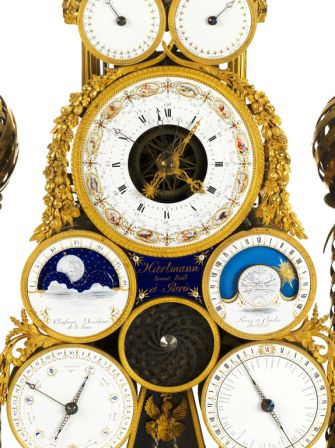 Francois-Joseph Hartmann
Francois-Joseph Hartmann
Few things are known on the beginnings of our clock and watch maker, Hartmann or Hartemann. According to the clocks that he produced we think that it began its activity at the late 18th century in Paris. During the first third of the 19th century, he is “horloger mécanicien pour l’Observatoire et la Marine”. We know several clocks with complications and multiple dials by Hartmann and was therefore a very skilled clock maker. In October 1793, it rented an flat and a shop rue des Viarmes and in 1814 bought the hotel of Italy with its furniture, located rue Saint Eustace for the sum of 9.500 francs.
Our clock maker took part in the second public exhibition of the products of the French industry in 1801. Its clock is recorded among the works exposed under the 63e “portiques”, there were 104 of them. It presents a clock with eight dials and received a honourable mention for “une pendule a hit cadrans, d’un travail soigne. Elle marque le lever, le coucher du soleil, les phases de la lune, &c”.
Taking into consideration these element, it is doubtless our clock.
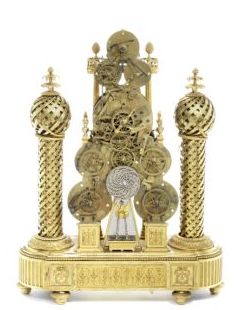 Joseph Coteau
Joseph Coteau
Born in Geneva in 1740, he becomes Master painter-enameller of the Academy of Luc Saint of Geneva in 1766 and settles in Paris a few years later. In 1772, it settles rue Poupée and remains there for the rest of his life in 1801. His name is attached to an enamel technique in relief which he develops with Parpette on some Sevres porcelain in particular the service of toilet of the Tsarina Maria Feodorovna and which he uses thereafter to decorate the enamels dials of clocks.
He remains the most known and most famous of the enamellers of the end of the 18th century and collaborated with the majority of the best clock and watch makers of this time. We frequently find his name painted on the back of the enamelled dials of the pendulums and clocks with multiple dials or complications.
A six figures bid justified for this exceptional clock in its model of a very great originality and a particularly neat mechanism. Also let us underline that this clock was unknown from the market since it was preserved in the same family for more than one century.
Each month, we organise auctions of fine continental furniture, antique clocks and works of art with our network of auctioneers. We invite you to contact us if you wish to include lots in our future sale. Valuations are free for auction.
If you need an appraisal for sale, insurance or inheritance, please contact us.
Cedric Henon, Continental furniture and works of art specialist.
Illustrations : Courtesy of Bonhams, Copyright © 2002-2011 Bonhams 1793 Ltd
» More

 June 22, a painting by Austrian expressionist Egon Schiele was sold by Sotheby's London more than 27 million euros ($40 million), multiplying by almost two the previous record held by Schiele in 2006. An exceptional work of art by both the subject and by the evidence she left in history.
A Museum Piece
« Häuser mit bunter Wäsche (Vorstadt II) » was sold by the Leopold Museum in Vienna, which now houses the largest collection of works by the artist but also many treasures of the Viennese Art Nouveau or the Wiener Werkstätte.
Known for his portraits and nudes, Egon Schiele makes this landscape in 1914, when he is at the top of his art. A rarity in the short career of the artist, who died at age 28.
 Sotheby’s London – 22 June 2011 Impressionist & Modern ArtEvening Sale Egon Schiele Häuser mit bunter Wäsche, “Vorstadt” II, 1914 100.5 x 120.5cm, Courtesy of Sotheby's
Sotheby’s London – 22 June 2011 Impressionist & Modern ArtEvening Sale Egon Schiele Häuser mit bunter Wäsche, “Vorstadt” II, 1914 100.5 x 120.5cm, Courtesy of Sotheby's
» More
|